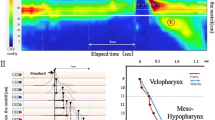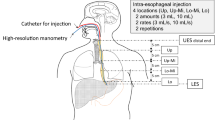Abstract
In 5 healthy volunteers, we studied the pressure-flow kinetics of the oral phase of swallowing. The regional profile within the oral cavity during swallowing was recorded, at the tongue tip (T1), dorsum of the tongue (T2), 3 cm from the tongue tip, oral floor, buccal cavity, and between the lips during swallows of water (0–20 ml) and 5 ml of mashed potato. Two strain gauge (SG) probes, each with two transducer recording sites 3 cm apart, were used for recording pressure. Supralingual and sublingual pressure were recorded concurrently. The relationship between transit of a barium bolus and deglutitive oral pressure phenomena was determined by concurrent videoradiography and manometry. Lingual pressure with the SG facing the tongue showed the most consistent recording and highest pressure: 193±16 (SE) mmHg at T1 and 214±18 mmHg at T2 for dry swallows. Pressures were similar for water swallows. However, mashed potato swallows produced a pressure of 383±30 mmHg at T1 and 485±52 mmHg at T2 that were greater than for water swallows (p<0.01). Pressure recorded with the transducers facing the hard palate and, to a lesser extent, laterally, was low and inconsistent. Oral-floor pressure was greatest with the transducers oriented upwards and averaged 64±2.9 mmHg proximally and 173±36 mmHg distally. At all sites the pressure waves propagated sequentially, toward the pharynx. Minimal pressure increases occurred in the buccal cavity. Lip squeeze varied from 0 to 90 mmHg.
We can draw the following conclusions. The oral phase of swallowing includes contraction of the oral floor, which provides a platform for tongue movement. Oral pressure waves propagate toward the pharynx so that a swallowed bolus is propelled ahead of the point of lingual-palatal closure. Lingual peristalsis exhibits a wide range of pressures, with lower pressure for dry and liquid boluses than for a semisolid bolus. Buccal and lip contractions act as stabilizing forces, but do not contribute to bolus propulsion. Significant differences exist in the radial pressure profile of lingual peristalsis, with maximal pressure oriented toward the tongue.
Similar content being viewed by others
References
Ramsey CH, Watson JS, Gramiak R, Weinberg SA: fluorographic analysis of the mechanism of swallowing.Radiology 64:498–518, 1955.
Donner MW: Swallowing mechanism and neuromuscul disorders.Semin Roentgenol 9:273–292, 1974.
Logemann J:Evaluation and Treatment of Swallowing Dorders. San Diego: College Hill Press, 1983.
Curtis DJ, Cruess DF, Dachman AH, Maso E: Tim in the normal pharyngeal swallow.Invest Radiology 19:523–529, 1984.
Dodds WJ, Hogan WJ, Lydon SB, Stewart ET, Stef Arndorfer RC: Quantitation of pharyngeal motor function in normal human subjects.J Appl Physiol 39:692–696, 19.
Orlowski J, Dodds WJ, Linehan JH, Dent J, Hogan W, Arndorfer RC: Requirements for accurate manometric cording of pharyngeal and esophageal peristaltic press waves.Invest Radiol 17:567–572, 1982.
Dodds WJ, Steff JJ, Hogan WJ: Factors determining presure measurement accuracy by intraluminal esophagmanometry.Gastroenterology 70:117–123, 1976.
Dodds WJ, Kahrilas PJ, Dent J, Hogan WJ: Considerati about pharyngeal manometry.Dysphagia 1:209–214, 19.
Doty RW: Neural organization of deglutition. (Sect. 6). In Code CF (ed):Alimentary Canal. Handbook of Physiology. Washington, D.C.: American Physiological Society, 1968.
Miller AJ: Neurophysiological basis of swallowing.Dysphagia 1:91–100, 1986.
Author information
Authors and Affiliations
Rights and permissions
About this article
Cite this article
Shaker, R., Cook, I.J.S., Dodds, W.J. et al. Pressure-flow dynamics of the oral phase of swallowing. Dysphagia 3, 79–84 (1988). https://doi.org/10.1007/BF02412424
Issue Date:
DOI: https://doi.org/10.1007/BF02412424




